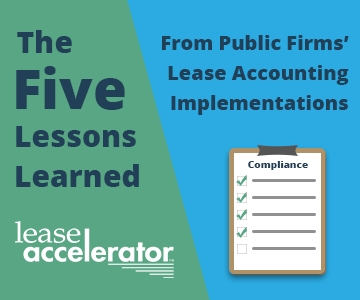Lease Accounting:
5 Lessons Learned from Public Company ASC 842 Implementations, How Private
Companies Can Avoid Making the Same Mistakes
By LeaseAccelerator,
a sponsor and friend of the Andersen
Alumni Association
We’re now seeing the first public company filings under ASC 842. While many made the deadline, most were not able to accomplish both the transition and setting up all of the back-end processes to maintain compliance. Many are still relying on manual workarounds while they work to establish long-term, automated strategies. The main reason why public companies fell behind was because they underestimated the burden of the standard.
We’re now less than 5 months out from the first private company deadlines, and many of these organizations are wondering how they can avoid the same scramble to compliance. The best way to get ahead at this point is to avoid the mistakes of public companies while also integrating some of their time-saving strategies.
1.
Find
Your Lease Data: Know Where to Look
The number one challenge cited by most public companies: collecting their lease data. This task actually requires two steps.
The first is to find all your leases so that you can prove completeness of your portfolio to auditors. For real estate leases, this may be straightforward if you have a corporate real estate arm that tracks property leases around the globe. However, most companies do not have a central repository for their equipment leases. Those contracts can be located in asset management systems – like for IT and Fleet – or in Excel spreadsheets stored on someone’s desktop. Then, you have to find any leases embedded in service contracts.
However, there are some tricks you can employ to help you find your complete lease portfolio. If you know you lease from a few large vendors, reach out to them to get a list of your leases. You can also work with Accounts Payable to get a record of every contract where you’re paying for an asset or service at set intervals. This is also a good way to find embedded leases. Work with Procurement to find any newly signed leases (or potential embedded leases). Finally, send out a survey to all asset users across the company to collect data on their leased assets.
The second step is collecting the lease data you will need for your reports and disclosures. There may be 100 data fields per lease you will need to fill out in order to correctly document the payment and term and calculate the value of the right-of-use assets and liabilities that will be reported on-balance sheet. Consider attributes like rent payment formulas, frequency, initial direct costs, and end-of-lease residual guarantees.
Unfortunately,
there is no short-cut for abstracting data. AI tools are far from ready to
abstract 100% of data from every lease. Some data may not even be in the lease,
but rather with vendors or within the minds of the asset users. In the end, it
will take a team of expert contract analyzers to tackle this step.
2.
Select,
Implement, and Integrate Lease Accounting Systems
Of course, once you abstract your data, you’ll need a place to put it. Most organizations have typically not used lease administration or accounting software in the past. Real estate administration and other asset management systems may be able to hold some of the information required by the new standard, but not all. And they won’t be able to perform accounting calculations. Given that the new standard requires each and every asset on the lease to be accounted for separately, most public companies with sizable lease portfolios opted to purchase a lease accounting software rather than try to handle ASC 842 on spreadsheets.
The selection phase of finding the right lease accounting software was a lengthy process for public companies, as they had to determine the required features, send out RFPs, and schedule demos. The implementation of the software can then take months.
You will
likely want to integrate the lease accounting system with your general ledger,
so that all of the asset-level journal entries in the lease accounting system
can be consolidated and uploaded into the GL. While many public companies did
not have time to integrate their lease accounting software with other systems
before the deadline, some are planning to integrate it with accounts payable
and asset management systems in order to keep all data in sync.
3.
Build
and Train the Project Team
The accounting team cannot handle this project alone. At most companies, leases are used by almost every business unit. To gather the leases and keep them up-to-date on an ongoing basis requires the accounting team to work with the groups actually using the assets. However, these groups don’t have the qualifications to make accounting judgements, so will need to be trained to recognize potential events that could lead to a reassessment or modification of the lease.
In addition, Accounting will most likely try to work with back-office units like Procurement to capture new leases as they are signed to maintain completeness. While Procurement will be able to recognize standard leases, they will not be able to make judgements on whether a service contract contains an embedded lease. Instead they will need to be trained to recognize potential embedded leases and send them over to Accounting for further evaluation.
Global
companies will need to create a process for working with regional accounting
teams to gather local leases and maintain accuracy of the data. How much responsibility
is given to regional accounting teams compared to the central accounting team
will largely depend on the organization. However, regional accounting teams
will need to be trained on the new lease accounting standards, as will any new
additions to the central accounting team.
4.
Establish
Long-Term Processes
If you’ve already started your lease accounting project, pause and imagine for a second how much time, effort, and money it has taken to find all current leases, keep track of changes to each asset on lease, and monitor whether new leases have been signed. Now imagine doing that forever. Without long-term processes, policies, and controls in place to ensure that your lease portfolio stays accurate and complete even after the deadline, you will constantly be playing that game of catch-up.
Some methods used by public companies for maintaining compliance have already been mentioned. Working with Procurement to capture new leases is one way. You may also want to create a control that for each purchase order (PO), that has Procurement document whether the PO contains an asset(s) that will be returned. You may also want to work with Treasury to set up a Lease versus Buy analysis policy for every asset request above a certain materiality threshold. This control will not only create an audit trail of all leases the company plans to enter into, but also ensure you are choosing the optimal method to finance your equipment.
Lastly, it
will be difficult to track all of the lease changes that can occur throughout
the lease lifecycle. For large lease portfolios, there may be hundreds of
changes per month that will need to be documented to keep all reports and
disclosures accurate. The employees that are responsible for the use of the
assets will have the most updated information, including end-of-term plans,
location changes, and early terminations due to lost or damaged assets.
Consider utilizing a system of notifications to regularly request attestations
from these groups.
5.
Test,
Test, Test!
The final
step is testing. This means not only testing systems, but also processes. Many
public companies found that the processes they had initially mapped out on
paper did not translate well in real life. The magical formula of processes
that will work for your company may only be discovered through trial and error.
For systems, it’s a bit easier to test whether or not the accounting output is
correct. Just be sure to test a variety of lease types, structures, and payment
schedules to ensure there are no errors.
Bonus: Reap
the Rewards
The lease
accounting standards have been a huge burden to implement and will likely
continue to be a burden until companies have a better grasp on their new
policies, processes, and controls. But luckily, unlike with other accounting
standard updates, ASC 842 has an upside. Increased insight into your lease data
and better control of your lease portfolio will open up opportunities for
savings. Accounting can provide Procurement with the data they need to secure
more negotiating power with lessors. They can help a business unit find an
evergreen asset (where payments continue to be made after the end of term).
There are lots of ways Accounting will be able to help the business save money
as a result of the standard.
About LeaseAccelerator
LeaseAccelerator offers the market-leading SaaS solution for Enterprise Lease Accounting, enabling compliance with new FASB and IFRS standards. Using LeaseAccelerator’s proprietary Global Lease Accounting Engine, customers can apply the new standards to all categories of leases including real estate, fleet, IT, and other equipment at the asset level. On average, LeaseAccelerator’s Lease Sourcing and Management applications generate savings of 17 percent on equipment leasing costs with smarter procurement and end-of-term management. Learn more at http://www.leaseaccelerator.com/.

